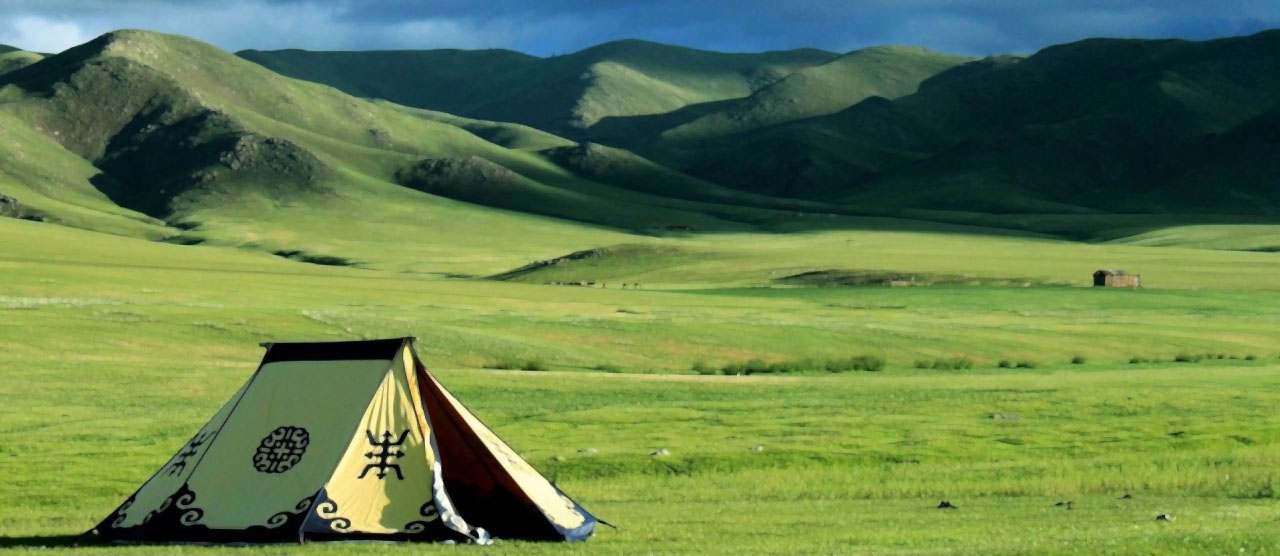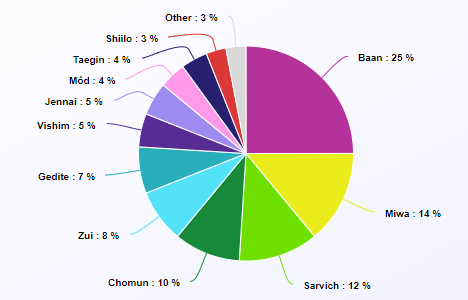Taalorang Empire
Physical Geography
The Vishim Desert is in the rain shadow of the Shiver Mountains and has one major river, the Zyengyi, running through it. It has very hot summers with little rain, during which time the population of its only city, Gadjae, expands due to its location on the river. Winters are very cold and frequently snow. Summer temperatures can reach over 40, while in the winter it plunges to -40, and agriculture is nearly impossible with its rocky, dry ground. Most residents are nomadic.
The steppe makes up the largest part of the empire. The broad Taalorang steppe covers the heart of the country, with civilization centring around Lake Rimra and the rivers that feed it. It has hot and dry summers followed by cool winters with sparse snow. Every spring, the grasslands erupt into carpets of wildflowers.
In the south, the steppe gives way to forests in the rainy Mangzmat region. This area has warm summers with frequent rain and cold, snowy winters. It has a mix of deciduous and coniferous trees.
The eastern coast is similar to the southern bay area, though warmer and with much more deciduous trees. It gets much more rain than the interior steppe and is responsible for much of the agriculture and lumber. Right along the coast, summers get large amounts of precipitation, with hot and humid summers and dry, cool winters with minimal snow.
Political Geography
Taalora is broken into 8 provinces. Only Mangzmat was a consolidated kingdom before being taken into the empire, and still has a king. The rest were full of small, nomadic clans and borders were drawn up in Temru for ease of administration.
The capital city is Temru, in the heart of the country on the shores of Lake Rimra. This was the home of the original conquerors of Taalora. It used to be an even mix of Baan and Gedite, but these days is quiet cosmopolitan with every ethnicity represented.
Demographics
Population: 14,238,385Capital: Temru (Pop. 166,282)
2nd largest city: Suitae (Pop. 83,141)
3rd Largest city: Mangzmat City(Pop. 54,042)
4th Largest city: Bodshko(Pop. 35,127) There are 11 main ethnic groups in Taalora. Most of them speak languages related to Baanang, the language spoken by the largest group and the lingua franca of Taalora. Baans: The largest group, spread across the southern steppe. About half of them live in major cities and permanent towns, with the other half maintaining their nomadic lifestyle and rotating in circuits around the steppe to. They were the original conquerors of Taalora and Baanang culture became the dominant across the region. Môds: Farmers and goatherds from the north. Vishim People: Residents of the Vishim Desert. Most are nomadic hunter-gatherers with limited interaction with the rest of Taalora. Gedites: Pastoral goatherds from the western steppes. Formerly nomadic, now most of them are settled in towns along the rivers or lakes. Sarvichs: A non-Baanic group from the Mangzmat prvince. Resisted Taalorang occupation for a long time. Fisherman and seafarers. Jennai: Similar to the Sarvichs but less influential. Mostly farmers or fishers. Majority of them still live in small, loosely connected villages with a central high king, with only about a third of them living under the Taalorang empire. Zuis: Herders from the southern steppes, with groups into the mountains. Chomuns: A non-Baanic group from the eastern steppe more closely related to the Shiilo than the other Baanic groups. They have more trade contact with the east coast. Miwa: a non-Baanic group from the eastern woodlands. They are mostly subsistence farmers and trade lumber with the Chomuns. Taegins: Only a small number of them live here, but the second largest city in Taalora is mostly a Taegin city. They’re more fishing inclined, and strongly independent. Shilo: In the past, the majority of Shilos were in the empire, but it has shrunk and now there are only a few. The eastern peninsula has a Shiilo kingdom of their own where the majority of them live.
Structure
The emperor is the head of the military and considered the second most powerful person in the military. The emperor is almost always the empress' husband, but in rare occasions, an empress has appointed an emperor and taken another husband, he receives the title of King Consort. If there is a reigning emperor, the head of the military is appointed and given the title King of Arms. Keeping the military and the legislative powers separate is an important cornerstone of Taalorang politics.
Below the empress are the governors of the provinces. The empire has rather loose centralization, with great freedoms to individual governors to rule as they see fit as long as taxes flow to Temru. Individual provinces are not allowed to have their own armies, however.
The governors rule over individual nobles who control smaller areas. Large parts of the steppe have no direct ruler, however. The open grasslands are considered open to all nomads and it is against imperial law to lay claim to these regions.
History
Over the next centuries, Taalora slowly expanded through more and more conquests. At its territorial peak, it owned all the land between the Vishim desert to the west to the Shiilogo peninsula to the east. The empire began shrinking about 150 years ago, after suffering a defeat. Since then, it's been in gradual decline. Although still one of the most powerful entities in the area, it has nowhere near the wealth or prestige of the past.
Maps
-
Map of Taalora and Aralia
A map of southeastern Kaabara showing Taalora, Aralia, and the unorganzied lands of various peoples.





